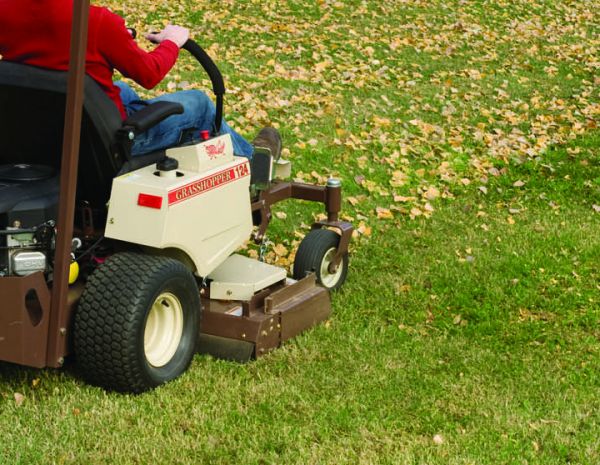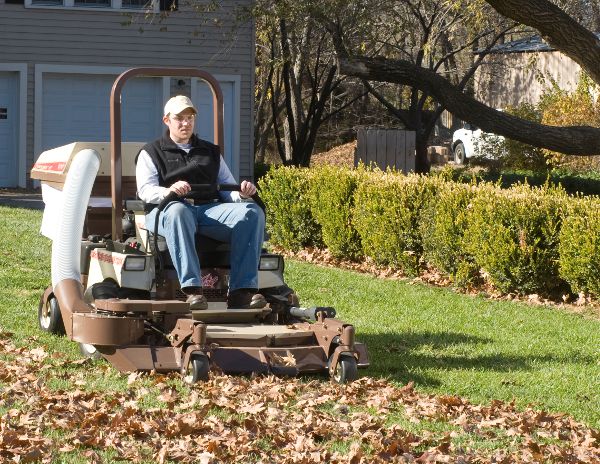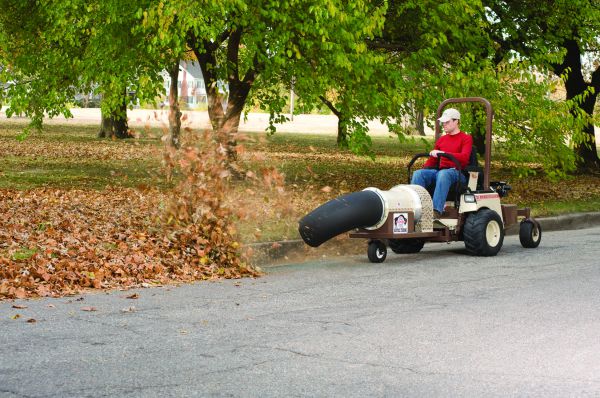Lawn Care Tip of the Month: Leaf removal
Posted on:Oct 26, 2016
This is Part X of our Lawn Care Tip of the Month blog series.
Wow, look at the date! What with GIE+EXPO — the industry's annual mega-show in Louisville — and other projects, this blog entry is a bit late. But, it's still October, which means the MLB Postseason is in full (ahem) swing, and no, we are not rooting for the Cubbies (Kansas is American League country, friends).
Enough about the Fall Classic. Let's turn our attention to another classic of fall. Leaves. LEAVES!
Yes, it's leaf season, which means you're trying to decide if you want to rake them and bag them, collect them with the mower and compost them, or mulch them up this year. We'd vote for one of the latter two, to save your back. 
Regardless of how you do it, leaf removal is an extremely important task. Continuously removing leaves throughout the fall season will keep them from matting down and smothering your lawn.
Allowing the leaves to accumulate into a thick layer also prevents the sunlight from reaching the grass. This ultimately suffocates the yard resulting in a spotty lawn with patches of dead grass and an increased potential of fungal diseases.
 The best approach to leaf removal is to take care of them as they fall throughout the season. You can do this by mulching or raking and collecting. Mulching is a lawn care method that returns grass clippings and leaves back to the soil through finely shredding a thin layer of leaves using a mulching mower. The grass clippings and leaves are composed of water and cellulose that decompose quickly, returning beneficial nutrients to the lawn. As the mower cuts the grass and leaves into fine pieces, it simultaneously directs the clippings deep into the lawn, saturating it with valuable nutrients. For more about mulching, along with helpful mulching tips, read Part VI.
The best approach to leaf removal is to take care of them as they fall throughout the season. You can do this by mulching or raking and collecting. Mulching is a lawn care method that returns grass clippings and leaves back to the soil through finely shredding a thin layer of leaves using a mulching mower. The grass clippings and leaves are composed of water and cellulose that decompose quickly, returning beneficial nutrients to the lawn. As the mower cuts the grass and leaves into fine pieces, it simultaneously directs the clippings deep into the lawn, saturating it with valuable nutrients. For more about mulching, along with helpful mulching tips, read Part VI.
The common alternative to mulching is raking and collecting the leaves. Though unappealing because of the time-consuming nature, raking is an effective method of leaf removal (it's a killer on your back though; best to give this chore to your kids).
 For large yards with an abundance of leaves, a vacuum collection system would be the most effective, such as the PowerVac Collection System for Grasshopper mowers. The PowerVac is a powerful, maneuverable and efficient, deck-driven vacuum perfect for quick and easy leaf-collecting. The rear-mounted collectors retain the mower’s zero-turn maneuverability, while the deck-mounted blower’s trash-ingesting steel impeller discharges the lawn debris directly into the vacuum collector, leaving you with a well-manicured lawn. Plus, it'll pick up just about any kind of debris for a clean finish with one pass and no overlap. You just have to match your mowing speed to the conditions — more volume and/or wet leaves will require a slower speed to get the best results.
For large yards with an abundance of leaves, a vacuum collection system would be the most effective, such as the PowerVac Collection System for Grasshopper mowers. The PowerVac is a powerful, maneuverable and efficient, deck-driven vacuum perfect for quick and easy leaf-collecting. The rear-mounted collectors retain the mower’s zero-turn maneuverability, while the deck-mounted blower’s trash-ingesting steel impeller discharges the lawn debris directly into the vacuum collector, leaving you with a well-manicured lawn. Plus, it'll pick up just about any kind of debris for a clean finish with one pass and no overlap. You just have to match your mowing speed to the conditions — more volume and/or wet leaves will require a slower speed to get the best results.
 If you're clearing leaves from congested areas or long stretches of sidewalks, curbs or other areas where a leaf collector cannot go, consider a front-mounted Turbine Blower. These out-front blowers attach in place of the out-front deck on Grasshopper FrontMount mowers, and with PTO-driven power, harness the airspeed velocity of a Category 4 hurricane to make quick and easy work of leaves, pine cones, pine straw and other debris.
If you're clearing leaves from congested areas or long stretches of sidewalks, curbs or other areas where a leaf collector cannot go, consider a front-mounted Turbine Blower. These out-front blowers attach in place of the out-front deck on Grasshopper FrontMount mowers, and with PTO-driven power, harness the airspeed velocity of a Category 4 hurricane to make quick and easy work of leaves, pine cones, pine straw and other debris.
No matter your approach for leaf collection, removing the leaves prior to the first winter snow is vital to the health of your spring lawn.

